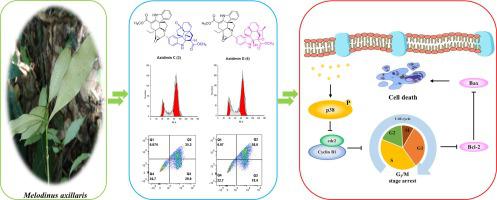Bioorganic Chemistry ( IF 4.5 ) Pub Date : 2023-09-06 , DOI: 10.1016/j.bioorg.2023.106841 Kaicheng Du 1 , Xingyao Li 1 , Changwei Zheng 1 , Lantao Lai 1 , Mingyi Shen 1 , Yumeng Wang 1 , Dali Meng 1

|
Four monoterpenoid indole alkaloid dimers (MIADs), axidimins A-D (1–4), which possesses unprecedented apidosperma-aspidosperma-type skeletons, along with twelve known MIAs were isolated from Melodinus axillaris. Their structures were established by comprehensive analysis of the HRESIMS, NMR, ECD calculation and DP4 + analysis. A possible biosynthetic pathway for axidimins A-D was proposed. In vitro, axidimins C and D exhibited significant cytotoxicities against HCT116 cells with IC50 values of 5.3 μM and 3.9 μM, respectively. The results obtained from flow cytometry and Western blot analysis clearly demonstrated that axidimins C and D significantly induced a reverse G2/M phase arrest and apoptosis of HCT116 cells. The potential mechanism of axidimins C and D on HCT116 cells were thoroughly discussed through the utilization of network pharmacology and molecular docking research. Subsequently, the selected targets were validated using Western blot and CETSA analysis, confirming that axidimins C and D exert its cytotoxic effects through the activation of the p38 MAPK pathway, ultimately leading to HCT116 cells death. This study provides evidence indicating that axidimins C and D have the potential to induce cell cycle arrest and apoptosis in HCT116 cells by modulating the p38 MAPK signaling pathway. These findings offer a novel perspective for the development of anti-colorectal cancer drugs.
中文翻译:

来自 Melodinus axillaris 的单萜吲哚生物碱二聚体通过 p38 MAPK 激活 HCT116 细胞诱导 G2/M 期停滞和细胞凋亡
从Melodinus axillaris中分离出四种单萜吲哚生物碱二聚体 (MIAD)、axidimins AD ( 1 – 4 ),其拥有前所未有的 apidosperma-aspidosperma 型骨架,以及十二种已知的 MIA 。通过HRESIMS、NMR、ECD计算和DP4+分析的综合分析确定了它们的结构。提出了 axidimins AD 可能的生物合成途径。在体外,axidimins C和D对HCT116细胞表现出显着的细胞毒性,IC 50值分别为5.3 μM和3.9 μM。流式细胞术和Western blot分析结果清楚地表明,axidimins C和D显着诱导HCT116细胞的反向G 2 /M期阻滞和凋亡。通过网络药理学和分子对接研究,深入探讨了axidimins C和D对HCT116细胞的潜在作用机制。随后,使用Western blot和CETSA分析对选定的靶标进行验证,证实axidimins C和D通过激活p38 MAPK途径发挥其细胞毒性作用,最终导致HCT116细胞死亡。这项研究提供的证据表明,axidimins C 和 D 有可能通过调节 p38 MAPK 信号通路来诱导 HCT116 细胞的细胞周期停滞和凋亡。这些发现为抗结直肠癌药物的开发提供了新的视角。


















































 京公网安备 11010802027423号
京公网安备 11010802027423号